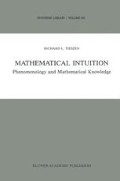Abstract
Most of the work that has been done by phenomenologists is concerned with the phenomenology of straightforward perception. It is in this area that one could expect to find the deepest and most illuminating analyses of Husserl’s general distinction between intentions and the fulfillment of intentions. Perceptual intuition may be considered generally to be a process which provides the relevant evidence for a person’s beliefs about medium-sized physical objects and about the physical world as a whole. Since the basic structure of the acts involved in ordinary perceptual intuition is supposed to be the same as that of the acts involved in mathematical intuition it would be a good idea to consider in more detail how the notion of fulfillment of intentions to ordinary perceptual objects is to be understood.
Access this chapter
Tax calculation will be finalised at checkout
Purchases are for personal use only
Preview
Unable to display preview. Download preview PDF.
Notes
Ideas, section 44. Boyce-Gibson’s and my translations.
EJ, section 8. The following passage in the text is also section 8.
EJ, section 8. On internal/external horizon discussed below see, for example, EJ section 8.
For a nice description of the temporal structure of straightforward perception see I. Miller’s Husserl, Perception, and Temporal Awareness [94].
Ideas, section 44. The following passage is also from section 44.
CM, section 22. Also, see Ideas, section 142.
Ideas, section 142.
Robin Gandy, “Church’s Thesis and Principles for Mechanisms” [36]; H. Dreyfus “What Computers Can’t Do” [22].
See e.g., Ideas, section 143.
Parsons’ “What is the Iterative Conception of Set?” [112].
Parsons’ “Quine on the Philosophy of Mathematics” [111], p. 191.
Ideas, section 138.
Ideas, section 131. See also section 129.
See Kaplan [73]. Also Smith and McIntyre, Husserl and Intentionality [128], pp. 213–222, 290–291, 359–360, 362–369. Also, Smith [125], [126], [127]. Also, I. Miller [94] on the behavior of the determinable “x”, pp. 60–80.
LI, I, section 26. For more material on “occassional expressions” see LI, VI, section 5.
CM, section 14.
Rights and permissions
Copyright information
© 1989 Kluwer Academic Publishers
About this chapter
Cite this chapter
Tieszen, R.L. (1989). Perception. In: Mathematical Intuition. Synthese Library, vol 203. Springer, Dordrecht. https://doi.org/10.1007/978-94-009-2293-8_3
Download citation
DOI: https://doi.org/10.1007/978-94-009-2293-8_3
Publisher Name: Springer, Dordrecht
Print ISBN: 978-94-010-7529-9
Online ISBN: 978-94-009-2293-8
eBook Packages: Springer Book Archive

